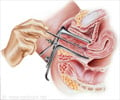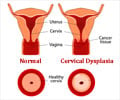- Cervical Cancer—Patient Version - (http://www.cancer.gov/cancertopics/screening/cervical)
About
Cervical cancer is often caused by an infection with human papilloma virus (HPV).
The cervix is the lower tubular part of the uterus that opens into the vagina. Cervical cancer accounts for nearly 20 percent of cancer related deaths in women in India. It is usually caused by an infection of the human papilloma virus (HPV). The virus spreads through sexual contact. The infection sometimes disappears on its own. In other cases, it causes changes in the cervical cells that could lead to cancer.
Pap smear is the most common test used in screening cervical cancer. It involves a study of the cervical cells to detect any abnormalities that could result in cancer. Though this test may not be 100% accurate, it helps to detect early changes in the cervix which can be easily treated.
Cervical Cancer Screening
Cervical cancer is often caused by an infection with human papilloma virus (HPV).
The cervix is the lower tubular part of the uterus that opens into the vagina. Cervical cancer accounts for nearly 20 percent of cancer related deaths in women in India. It is usually caused by an infection of the human papilloma virus (HPV). The virus spreads through sexual contact. The infection sometimes disappears on its own. In other cases, it causes changes in the cervical cells that could lead to cancer.

Pap smear is the most common test used in screening cervical cancer. It involves a study of the cervical cells to detect any abnormalities that could result in cancer. Though this test may not be 100% accurate, it helps to detect early changes in the cervix which can be easily treated.
When should screening for cervical cancer with Pap smear be started?
Screening for cervical cancer should start three years after the first sexual intercourse or after the age of 21, whichever is earlier.
How frequently should Pap smear be done?
Pap smear should be repeated every 1 to 3 years till the age of 65 years. Following this, the doctor will decide whether you still need the test based on whether you are sexually active or if your previous tests were abnormal.
What are the various screening procedures for cervical cancer?
Cervical cancer screening is usually done by obtaining a Pap smear. In this procedure, some cervical cells are obtained with a swab from the cervix and sent to the laboratory to check for cancerous changes. Other new techniques for cervical cancer screening include visual interpretation with acetic acid (VIA) and human papilloma virus (HPV) DNA testing. VIA allows immediate diagnosis and treatment. Thus, the patient does not need to be recalled to collect the report once the test is done. It also required minimal training of the paramedical staff to carry out this test. HPV is often associated with cervical cancer, thus detecting HPV DNA helps in finding women at increased risk for cervical cancer.
Human PapillomaVirus (HPV) vaccine
The human papilloma virus (HPV) vaccine preventsinfection caused by human papillomavirus associated with the development ofcervical cancer. Gardasil andCervarix are the two HPV vaccines which are currently available on themarket. In many countries HPV vaccination is approved for use in males.








